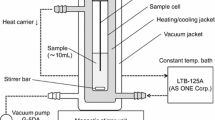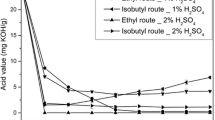Abstract
Biodiesel is a renewable alternative fuel made from plant oils and animal fats that may be burned in a compression–ignition (diesel) engine. It is composed of mono-alkyl fatty acid esters made from plant oils or animal fats mainly by transesterification with methanol or ethanol. This process leaves behind small concentrations of minor constituents including monoacylglycerols (MAG). Saturated MAG have low solubility in biodiesel and may form solid residues during storage in cold weather. Soybean oil-fatty acid methyl esters (SME) were mixed with up to 1.0 mass% MAG to evaluate the effects on cloud point (CP), freezing point (FP), cold filter plugging point (CFPP), and wax appearance point (WAP). Differential scanning calorimetry (DSC) results showed that MAG with only 27.6 mass% total long chain (C16–C18) saturated fatty acid content had melting transitions between 54 and 59.0 °C. Furthermore, DSC analysis indicated that pure monoolein may be problematic with respect to melting transitions between 25.4 and 33.4 °C. Solubility data for SME–MAG mixtures indicated a broad transition temperature range from solid at low temperature to liquid at temperatures exceeding 60 °C. Increasing the added MAG content from 0.10 to 1.0 mass% increased both CP and FP. Cold filter plugging point demonstrated higher sensitivity than CP or FP at added MAG content below 0.10 mass%, though it was not affected by increasing MAG concentration above 0.50 mass%. Wax appearance point showed no effects until added MAG content exceeded 0.25 mass%. Kinematic viscosity measured at 5 °C similarly showed no effects until added MAG concentration exceeded 0.20 mass%. Specific gravity at 15.6 °C and refractive index at 25 °C were not greatly affected by added MAG except at concentrations greater than 0.10 mass%.











Similar content being viewed by others
References
Knothe G (2010) Introduction. In: Knothe G, Krahl J, Van Gerpen J (eds) The biodiesel handbook, 2nd edn. AOCS Press, Champaign, pp 1–3
Mittelbach M, Remschmidt C (2004) Biodiesel—the comprehensive handbook. Martin Mittelbach, Graz
Howell S, Jobe J (2010) Biodiesel in the United States. In: Knothe G, Krahl J, Van Gerpen J (eds) The biodiesel handbook, 2nd edn. AOCS Press, Urbana, pp 299–314
Freedman B, Butterfield RO, Pryde EH (1986) Transesterification kinetics of soybean oil. J Am Oil Chem Soc 63:1375–1380
Van Gerpen J, Knothe G (2010) Basics of the transesterification reaction. In: Knothe G, Krahl J, Van Gerpen J (eds) The biodiesel handbook, 2nd edn. AOCS Press, Champaign, pp 31–46
Freedman B, Pryde EH, Mounts TL (1984) Variables affecting the yields of fatty esters from transesterified vegetable oils. J Am Oil Chem Soc 61:1638–1643
ASTM (2010) Standard specification for biodiesel fuel blend stock (B100) for middle distillate fuels. In: Annual book of ASTM standards. ASTM International, West Conshohocken (PA), method D 6751
Kotrba R (2006) Bound by determination. Biodiesel Mag 3:42–50
Dunn RO (2009) Effects of minor constituents on cold flow properties and performance of biodiesel. Prog Energy Combust Sci 35:481–489
Pfalzgraf L, Lee I, Foster J, Poppe G (2007) Effect of minor components in soy biodiesel on cloud point and filterability. In: Inform supplement—biorenewable resources no. 4. AOCS Press, Champaign, pp 17–21
Selvidge C, Blumenshine S, Campbell K, Dowell C, Stolis J (2007) Effect of biodiesel impurities on filterability and phase separations from biodiesel and biodiesel blends. In: Proc, 10th International Conference on Stability, Handling and Use of Liquid Fuels. International Association for the Stability and Handling of Liquid Fuels, Atlanta
Van Gerpen JH, Hammond EG, Johnson LA, Marley SJ, Yu L, Lee I, Monyem A (1996) Determining the influence of contaminants on biodiesel properties. In: Report prepared for the Iowa Soybean Promotion Board (http://www.biodiesel.org/resources/reportsdatabase/reports/gen/19960731_gen014.pdf)
Yu L, Lee I, Hammond EG, Johnson LA, Van Gerpen JH (1998) The influence of trace components on the melting point of methyl soyate. J Am Oil Chem Soc 75:1821–1824
Allen CAW, Watts KC, Ackman RG, Pegg MJ (1999) Predicting the viscosity of biodiesel fuels from their fatty acid ester composition. Fuel 78:1319–1326
Pradhan A, Shrestha DS (2007) Impact of some common impurities on biodiesel cloud point. In: Proc, ASABE Annual International Meeting. American Society of Agricultural and Biological Engineers, St Joseph (MI), paper no. 076090
Tang H, Salley SO, Ng KYS (2008) Fuel properties and precipitate formation at low temperature in soy-, cottonseed-, and poultry fat-based biodiesel blends. Fuel 87:3006–3017
Tang H, De Guzman RC, Salley SO, Ng KYS (2008) Formation of insolubles in palm oil-, yellow grease-, and soybean oil-based biodiesel blends after cold soaking at 4°C. J Am Oil Chem Soc 85:1173–1182
ASTM (2003) Standard test method for determination of free and total glycerine in B-100 biodiesel methyl esters by gas chromatography. In: Annual book of ASTM standards. ASTM International, West Conshohocken (PA) method D 6584
ASTM (2003) Standard test method for flash point by Pensky-Martens closed cup tester. In: Annual book of ASTM standards. ASTM International, West Conshohocken (PA), method D 93
ASTM (2003) Standard test method for kinematic viscosity of transparent and opaque liquids (and the calculation of dynamic viscosity). In: Annual book of ASTM standards. ASTM International, West Conshohocken (PA), method D 445
ASTM (2003) Standard test method for cloud point of petroleum products (constant cooling rate method). In: Annual book of ASTM standards. ASTM International, West Conshohocken (PA), method D 5773
AOCS (1998) Free fatty acids. In: Firestone D (ed) Official methods and recommended practices of the AOCS, 5th edn. AOCS Press, Champaign, method Ca 5a-40
CEN (2006) Fat and oil derivatives—Fatty acid methyl esters (FAME)—Determination of Ca, K, Mg and Na content by optical emission spectral analysis with inductively coupled plasma (ICP OES). European Committee for Standardization Press, Brussels, method EN 14538
CEN (2003) Fat and oil derivatives—fatty acid methyl esters (FAME)—determination of oxidation stability (accelerated oxidation test). European Committee for Standardization Press, Brussels, method EN 14112
AOCS (1998) Determination of mass per unit volume (‘‘liter weight’’) in air of oils and fats. In: Firestone D (ed) Official methods and recommended practices of the AOCS, 5th edn. AOCS Press, Champaign, method Cc 10c-95
ASTM (2003) Standard test method for refractive index and refractive dispersion of hydrocarbon liquids. In: Annual book of ASTM standards. ASTM International, West Conshohocken (PA), method D 1218
Shantha NC, Decker EA (1994) Rapid, sensitive, iron-based spectrophotometric methods for determination of peroxide values of food lipids. J AOAC Int 77:421–424
ASTM (2003) Standard test method for freezing cloud point of aviation fuels (automatic phase transition method). In: Annual book of ASTM standards. ASTM International, West Conshohocken (PA), method D 5972
ASTM (2005) Standard test method for cold filter plugging point of diesel and heating fuels. In: Annual book of ASTM standards. ASTM International, West Conshohocken (PA), method D 6371
ASTM (2003) Standard test method for wax appearance point of distillate fuels. In: Annual book of ASTM standards. ASTM International, West Conshohocken (PA), method D 3117
Dunn RO, Moser BR (2010) In: Knothe G, Krahl J, Van Gerpen J (eds) The biodiesel handbook, 2nd edn. AOCS Press, Champaign, pp 147–203
Hagemann JW (1988) Thermal behavior and polymorphism of acylglycerides. In: Garti N, Sato K (eds) Crystallization and polymorphism of fats and fatty acids. Marcel Dekker, New York, pp 9–95
Verheecken J, Meeussen W, Foubert I, Lesaffer A, Wouters J, Dewettinck K (2009) Comparing the crystallization and polymorphic behavior of saturated and unsaturated monoglycerides. Food Res Int 42:1415–1425
Dunn RO (1999) Thermal analysis of alternative diesel fuels from vegetable oils. J Am Oil Chem Soc 76:109–115
Chupka GM, Yanowitz J, Chiu G, Alleman TL, McCormick RL (2011) Effect of monoglyceride polymorphism on low-temperature performance of biodiesel. Energy Fuels 25:398–405
Acknowledgments
Dr. Ron Holser provided early consultation and advice for studying the formation of solid monoacylglycerol residues in biodiesel. Dr. Jill Moser provided guidance for analyzing peroxide values. Kim Ascherl, Benetria Banks, Becky Sanders, Kevin Steidley, and Erin Walter prepared and performed experiments for DSC, cold flow and other fuel properties of samples in support of the present study.
Author information
Authors and Affiliations
Corresponding author
Additional information
Mention of trade names or commercial products in this publication is solely for the purpose of providing specific information and does not imply recommendation or endorsement by the US Department of Agriculture. USDA is an equal opportunity provider and employer.
About this article
Cite this article
Dunn, R.O. Effects of Monoacylglycerols on the Cold Flow Properties of Biodiesel. J Am Oil Chem Soc 89, 1509–1520 (2012). https://doi.org/10.1007/s11746-012-2045-7
Received:
Revised:
Accepted:
Published:
Issue Date:
DOI: https://doi.org/10.1007/s11746-012-2045-7




